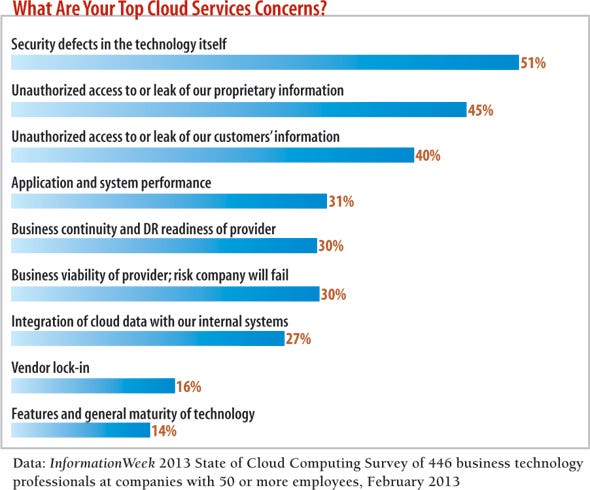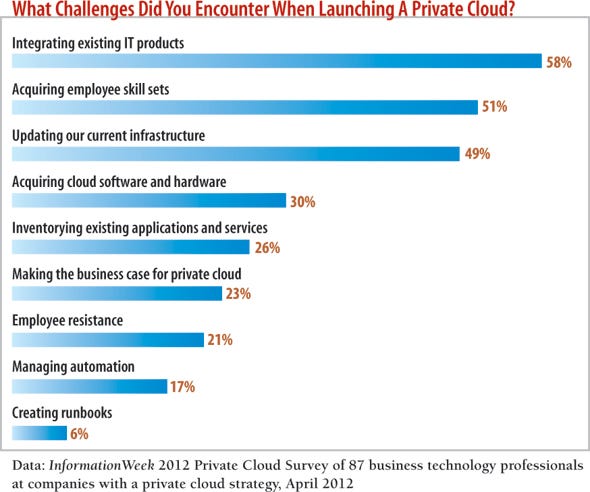Think private clouds offer all the flexibility and none of the risk? IT is missing out if it doesn’t prepare for public cloud use.

IT is under pressure to build private clouds, which means creating a data center architecture that can deliver the same kind flexible, scalable computing as public clouds from Amazon Web Services and other providers. And private clouds do so without the security and control worries that come with sending data outside a company's own walls.
However, with private clouds IT professionals face a dilemma between two competing goals: They want to build private clouds that are open to other clouds but also can run existing in-house systems and applications. Private clouds must be as open and standard as possible so, if necessary, you can shift workloads out to public clouds at times of peak demand (known as cloudbursting). Many IT pros look to OpenStack and other open source code that's based as much as possible on Web standards and nonproprietary languages, such as Python.
Get Our Buyer's Guides For Cloud Infrastructure

IaaS Buyer's Guide
Our buyer's guides examine infrastructure-as-a-service and platform-as-a-service, and they're free with registration.What you'll find:
Comparisons of vendors' IaaS and PaaS offerings
Analysis of IaaS and PaaS strategies and use cases
But IT also wants its private cloud architecture to work with what it already owns. If what you have is a data center that's heavily virtualized using VMware or a bunch of Windows Server hosts running Hyper-V virtual machines, those platforms offer strong, in-house management features but make openness and standardization difficult. VMware and Hyper-V represent just under two-thirds of the enterprise virtualization market, according to IDC. Both will gladly supply the means to build a private cloud data center, but neither matches up perfectly with the de facto public cloud standard -- Amazon Web Services, another proprietary system.
Among the key advantages of private clouds is that they let you self-provision virtual servers. They also provide elastic scaling of those servers, let you shift workloads to any machine depending on demand, launch servers without human intervention and supply end users with an accounting of the resources they've used either for chargeback purposes or often just for showback.
Private clouds have stirred up a lot of interest because they represent a step forward in data center design, relying heavily on pools of virtualized resources. Theoretically at least, they can be run as much by software programming as by humans, hence the VMware-coined term the "software-defined data center." Companies can build smaller data centers using cloud architecture because, by shifting workloads among general-purpose servers, storage and networks, utilization goes way up. FedEx estimates that moving to a private cloud architecture let it build just a 20,000-square-foot, 10-megawatt data center instead of the 100,000-square-foot, 30-megawatt building it had planned before embracing a strategy its IT leaders describe as "all in" on a private cloud design.
Many companies building private clouds want to be able to tap public clouds during peak demand -- relieving them from having to buy infrastructure to support two or three times their usual steady state. While they want the option of using these blended private-public clouds, few IT leaders are running critical apps in a hybrid private-public cloud.
FedEx CIO Rob Carter says there's no doubt that his company will tap a public cloud in the near future. FedEx will need more data center capacity, and a public cloud may be able to provide that on demand and with less capital investment. FedEx also will need computing capacity around the world to ensure fast response times, and public clouds might be a better choice than building private ones.
Whatever the reason, the point is that FedEx built its Colorado data center architecture using the same principles as a public cloud. Every server is capable of running any application that's in the data center, for example, because every application that FedEx moved to this "pristine" data center was rewritten to use the same software stack. "When we do take that next step with Tier 1 applications in the public cloud, we've already been behaving that way in- house," says Kevin Humphries, FedEx's senior VP in charge of the data center infrastructure.
VMware's Hybrid Hopes
Once companies have created pools of virtualized resources in a private cloud, IT needs a way to let end users self-provision virtual servers and see what the resources they've commissioned are costing the company. Users need a service catalog of their server options for a given computing task. And IT needs a monitoring system that will do the routine work of keeping things running, spotting trouble as it develops, and commissioning and decommissioning VMs.
VMware does most of this in its on-premises vSphere environment, but so far it hasn't convinced many customers to use the VMware-based public clouds it provides through partners as a path to hybrid cloud operations. VMware partners with Colt, SingTel and SoftBank overseas and AT&T, Bluelock, CSC and Dell in the United States. Hundreds of smaller regional partners claim VMware compatibility as well.
A certain nervousness is evident in the VMware camp, as it watches Amazon become the first name in public cloud infrastructure by cutting prices that others such as Microsoft then match. "We all lose if [corporate applications] end up in these commodity public clouds," VMware CEO Pat Gelsinger said at a Feb. 27 partner meeting in Las Vegas. "We want to extend our franchise from the private cloud into the public cloud and uniquely enable our customers with the benefits of both. Own the corporate workload now and forever." VMware's COO, Carl Eschenbach, urged partners not to lose out to a "company that sells books."
But Terremark, a Verizon-owned data center colocation and cloud services provider and long-term VMware partner, illustrates VMware's problem. Terremark wants to host as many VMware-based workloads as possible, and its executives frequently appear on stage at VMworld user group meetings. But it's developing its own cloud management software rather than base its operations on VMware vCloud Suite, which it has found unsuitable for its large-scale operations, says John Considine, Terremark's CTO.
Many observers, including James Staten at Forrester Research, predict VMware will enter the public cloud market and offer VMware-compatible infrastructure-as-a-service.
The OpenStack Option
Open source code projects are generating a lot of energy and innovation in the private cloud software arena these days. In particular, OpenStack, a project that started with Rackspace and NASA in July 2010, offers a way for companies to build a private cloud that promises to be compatible with a variety of public clouds. Hewlett-Packard and Rackspace already have public OpenStack clouds in operation, and IBM promises to bring its SmartCloud and its cloud consulting services into line. FedEx has used some proprietary systems to get its private cloud started, but soon "we will be OpenStack compliant," says Humphries.
OpenStack provides for virtual machine provisioning and management, much as Microsoft and VMware do, but its primary hypervisor is open source KVM. OpenStack backer IBM has taken to publicizing what it sees as the efficiencies of KVM over VMware's ESX Server hypervisor, something that only KVM's owner, Red Hat, had done before. Thus, this fast-growing, open source private cloud initiative strikes at the heart of VMware's product empire.
OpenStack supplies an end user portal for self-provisioning, and virtual machines use tracking to provide chargeback statements. It allows for load balancing and the automated spinning up of more servers to meet demand, if policies dictate an increased service level.
OpenStack has its critics, including those who say it's really a set of projects and not a single, enterprise-friendly product. Companies that download OpenStack's six major service modules must do a lot to get them working together. Several companies, including Canonical, Cloudscaling, Mirantis, Nebula, Nimbula, Piston, Red Hat and SUSE, provide services around OpenStack.

chart: What Are Your Top Cloud Service Concerns?
OpenStack can't match Microsoft in Hyper-V virtual machine management; it can't beat VMware at generating and live migrating ESX Server VMs. But OpenStack promises to handle KVM as well as ESX Server and Hyper-V workloads, providing multiple cloud options.
Perhaps most interesting -- to open source newcomers and established vendors -- is OpenStack's network virtualization and software-defined networking project, called Quantum. VMware, Juniper and Cisco have joined the Quantum project in part because contributing to it lets them influence and understand where the technology is headed. Networking is the last function in the data center to be virtualized, and all private cloud system producers are intensely focused on it.
No Time For Open Source Purists
OpenStack is advancing quickly. It's on its seventh release in less than three years, but it's not a universal standard. HP OpenStack differs from Rackspace OpenStack in some implementation details; Rackspace is different from Ubuntu OpenStack, which is different from Red Hat OpenStack.
The goal of the initial OpenStack project was to let a thousand private and public clouds bloom, instead of having just a few giant public cloud providers such as Amazon and Google. The hope was that all these providers would be based on one core set of cloud software and would be interoperable. The OpenStack Foundation remains committed to that goal, but OpenStack has so many open-ended options that early implementers have had to make compromises that limit interoperability.
HP and Rackspace, both early OpenStack cloud builders, have been criticized for implementing the software in ways that are unique to their operations. Nebula, the startup former NASA CIO Chris Kemp founded, offers OpenStack as a configured hardware appliance to be plugged into a server rack; Piston offers it configured in a different way on a memory stick that loads into a top-of-rack switch. Red Hat, SUSE and Ubuntu offer it as part of a Linux distribution, using different OpenStack releases and different tweaks to those releases.
In "hustling to release a full suite of open cloud products built on OpenStack," director of cloud compute engineering Troy Toman says in a blog post, Rackspace "...created some implementation specifics that were out of sync with common practices in other OpenStack implementations."
Beyond OpenStack
It isn't only OpenStack that's in flux but the whole realm of open source code for private cloud computing. Eucalyptus Systems, for instance, does many of the same things as OpenStack but in an Amazon-specific context. Its open source APIs are compatible with Amazon Web Services' APIs, so if you're already an Amazon customer, you can develop a compatible private cloud on premises and your workloads will run in both. Critics complain that an open source project shouldn't be tied to a proprietary vendor's approach. Given Amazon's popularity, "we think it would be lunacy not make those two things compatible," counters Eucalyptus CEO Marten Mickos.
Somewhere in between OpenStack and Eucalyptus is a commercial implementation of OpenStack from Cloudscaling, called the Open Cloud System. Cloudscaling is betting that both OpenStack and Amazon are long-term survivors in cloud computing and it supports both of their APIs. "Amazon is a de facto standard," says Randy Bias, CTO of Cloudscaling. Even the most stringent open source advocates must support it, he says.
Three Private Cloud Approaches
OpenStack is just now coming together as a set of cloud computing modules, so few large companies are implementing it. And those companies that are implementing it are careful in how they talk about it. PayPal, for example, has devoted a few servers to an OpenStack implementation and is running two "isolated" applications on them. That is, it's running two applications that can operate independently of each other and with few dependencies on PayPal's software infrastructure outside their own application logic. (The PayPal project gained notoriety because it was reported as a sign that parent company eBay -- with its many thousands of servers -- would adopt OpenStack and replace VMware software throughout the company. That isn't correct, a PayPal spokesman says, although it made no guarantees to any vendor.)

chart: What Challenges Did You Encounter When Launching a Private Cloud??
A common criticism of OpenStack is that the code is only loosely integrated; one of the six services works fine but a second and third don't work robustly with it. PayPal offers some counter-testimony. Its private cloud "went from idea to reality in six weeks," says Saran Mandair, in an email exchange. Once in operation, an engineer ran into a problem launching a workload and, facing a 45-minute deadline, sought support from developers on the OpenStack chat board. Within 10 minutes, he had seven or eight helpful responses and solved the problem and still made his deadline, Mandair says.
Eucalyptus is criticized for riding on Amazon Web Services' coattails, but one implementer, AppDynamics, an application performance monitoring software maker, has found a mission-critical use for it. AppDynamics' marquee customer, Netflix, uses AppDynamics to watch its customer-facing systems running in the Amazon cloud.
AppDynamics tests whether its systems are working in an Amazon environment by using virtual machines to mimic activity of thousands of server CPUs, banks of RAM, storage devices and transactions. But doing those tests on Amazon's cloud often hits limits AppDynamics set on Amazon capacity. Its solution was to build an AWS-compatible cloud in-house using Eucalyptus software running on 21 blades. With minor tweaks, AppDynamics was able to use the same scripting infrastructure it had used on Amazon because the Eucalyptus APIs behaved in identical ways.
Trek Bicycle is typical of many enterprise IT teams: It's exploring different cloud paths, testing two private cloud options while increasing its use of the public cloud. The private cloud approaches it's looking at include a VMware virtualized data center at its headquarters and the increasing use of Windows Server with Hyper-V for its Microsoft application, database and development environment.
Trek is "dabbling in private cloud" with the installation of VMware vCloud director software, says Adam Salvo, DevOps manager for Trek's Ascend retail point-of-sale and dealer management application. Trek is using vCloud to let some employees self-provision VMs. At the same time, however, teams working on the POS software and business intelligence are making use of Microsoft's Azure cloud service. Trek's Microsoft development has moved onto Azure, where C# tools and a SQL Server-compatible database service are readily available. Five developers work on the &dcThree;POS system in Trek's headquarters and two work remotely, but all access the same development tools and project software on Azure. They also use Azure's online computing capacity to perform software testing and quality assurance to avoid overburdening headquarters systems. Trek also uses Azure to stage pre-production systems to make sure they'll run as planned.
Trek hasn't mapped out its cloud strategy yet, but Salvo says it might make sense to run business analysis reports it does for independent bike shop owners on Azure and let the shop owners access them there, while keeping core business data on premises in SQL Server. What about its VMware virtualized data center? Salvo says it could use tools that convert a VMware virtual machine into a Hyper-V VM, to ensure that VMware workloads can find an external host if needed in Azure.
There are few clear choices in today's private cloud debate. But the trick isn't making that one perfect choice, because there isn't one option --VMware, Microsoft, Amazon, OpenStack -- that IT can embrace for all its private cloud needs. The trick is to avoid creating a private cloud that won't smoothly mesh with a public cloud should you ever want it to. A private cloud architecture has considerable flexibility and cost savings advantages, but the hybrid private-public data center infrastructure will be reality soon for many more companies. --With Chris Murphy
About the Author(s)
You May Also Like







